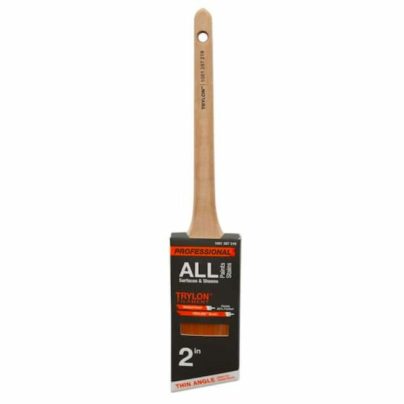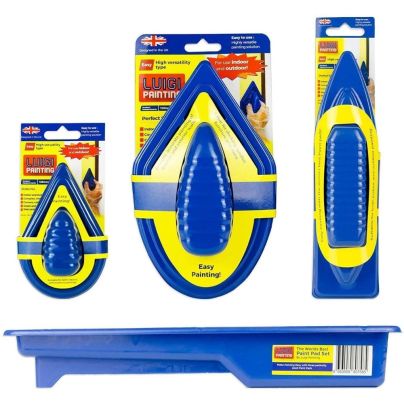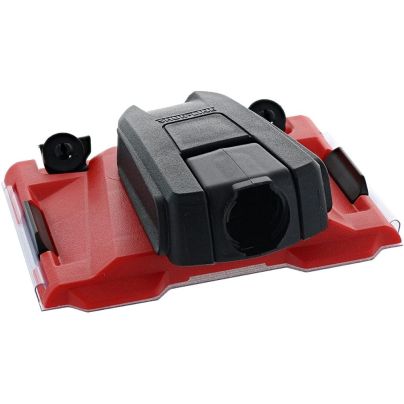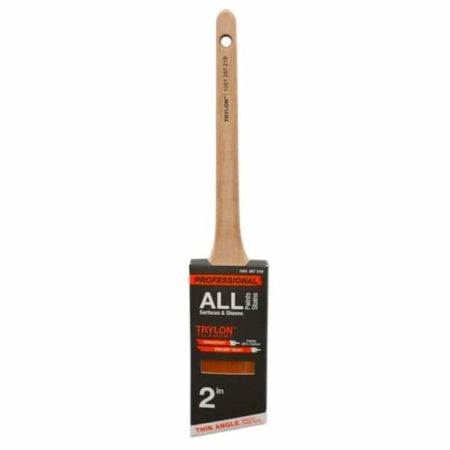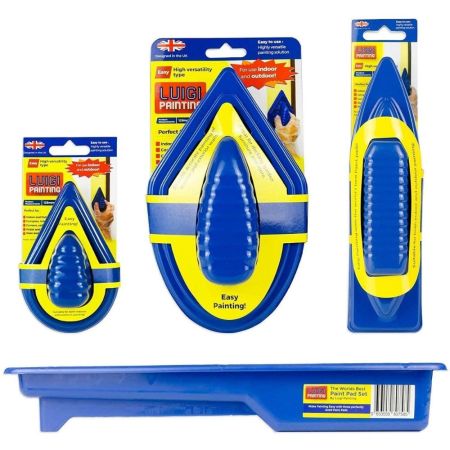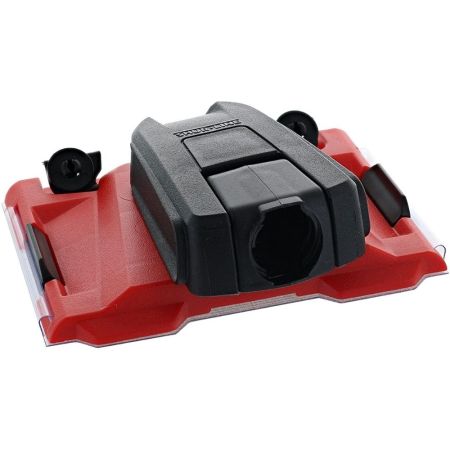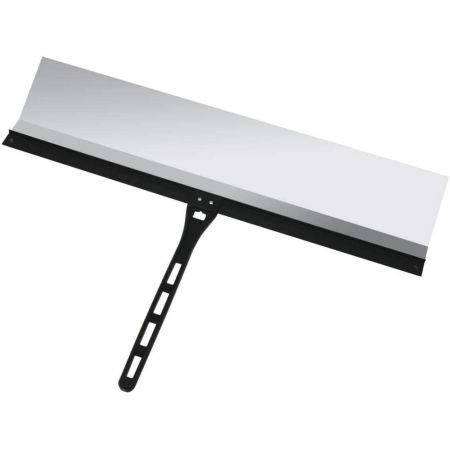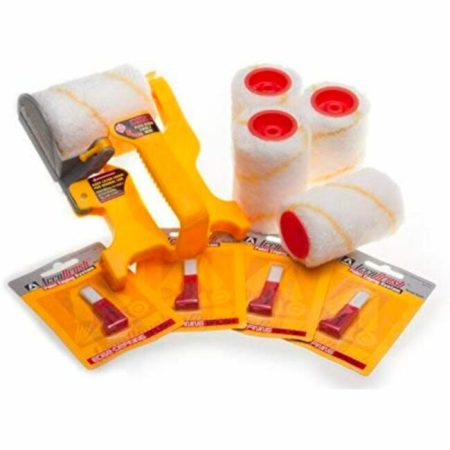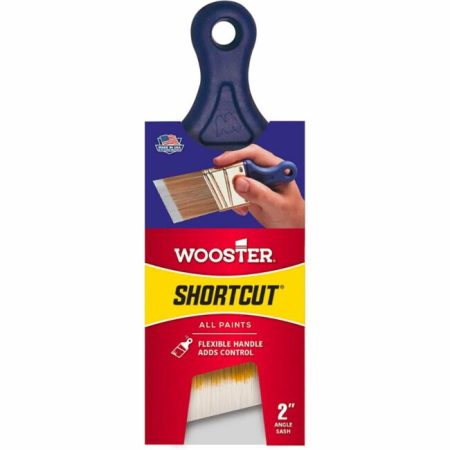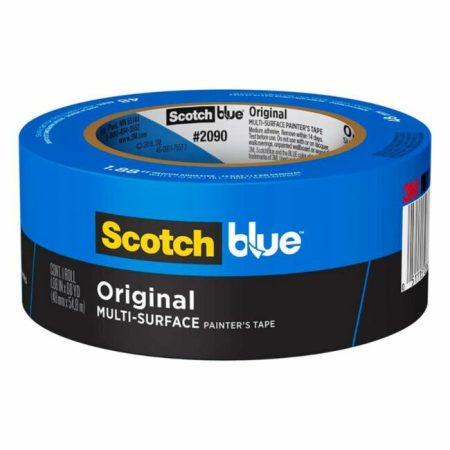We may earn revenue from the products available on this page and participate in affiliate programs. Learn More ›
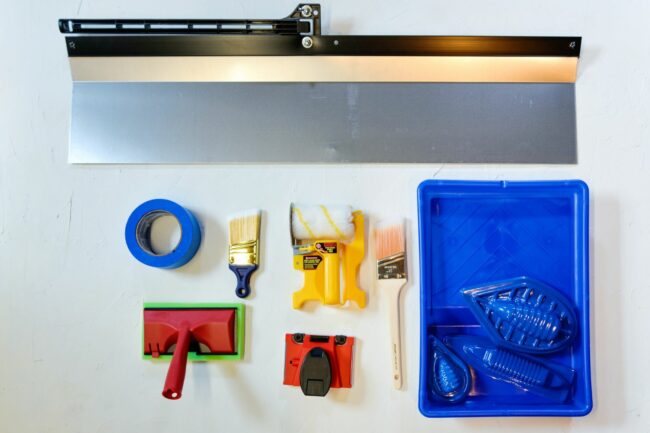
Crisp, clean edges are the hallmark of a great paint job. To get professional-quality results when painting a room, first clean, patch, sand, and prime the walls—only then should painting begin. For neat results around the ceiling and trims, consider using a paint edger. These handy tools are used as an alternative to the painter’s tape that would otherwise be placed along the edges of the ceiling, baseboard, and window/door trim to keep these areas free of paint.
Using a paint edger saves time and money because it eliminates the need to tape off ceilings and baseboards. But not all paint edgers are suited for all projects; some, for instance, may be best for spray-painting. We talked to a general contractor to get additional expert advice when choosing our lineup.
To help DIYers achieve flawless results, we decided to field-test some of the most popular products designed for the task of paint edging. We researched and employed dozens of paint-edging tools to find excellent options for common household projects. Read on to learn about shopping considerations, how each tool performed in tests, and why I consider those listed below to be the best paint edgers around.
- BEST OVERALL: Pro Grade Supplies 2-Inch Angled Sash Paint Brush
- BEST BANG FOR THE BUCK: Luigi’s The World’s Best Paint Pad Set
- BEST PROFESSIONAL: Shur-Line Edger Pro
- BEST FOR SPRAYING: Warner Tool 36-Inch Spray Shield
- BEST EDGER KIT: Accubrush 11-Piece MX Jumbo Kit
- BEST EDGING BRUSH: Wooster Brush Shortcut Q3211
- BEST EDGING TAPE: ScotchBlue Original Painter’s Tape
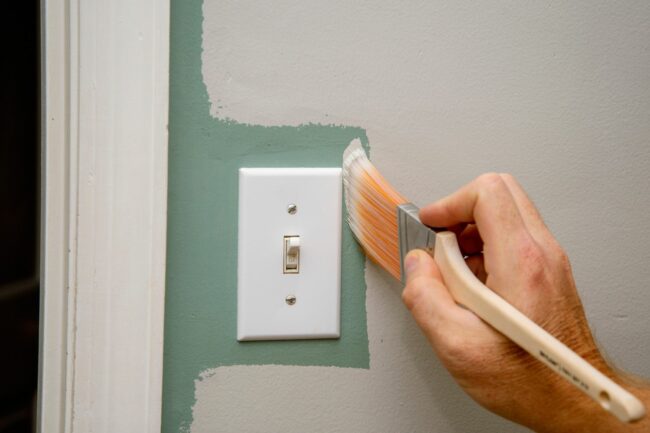
How We Tested the Best Paint Edgers
First we interviewed Ben Illig, a general contractor with decades of experience and owner of Illig Properties in Pennsylvania. He says the great thing about paint edgers is that, “for a DIY painter, they’re a way to achieve sharp lines with little experience.” When asked about preferred features, he added, “I also look for how easily the edger can be cleaned. If you have to take the tool apart to wash it, that slows down the production.” This, in addition to being easy to insert the paint in the first place, were our top considerations when choosing our recommended products. We took this expert advice in mind and got our hands on them for testing.
I converted an average bedroom into a paint-edger testing lab to find out where each of the chosen products would excel. I spent 8 hours testing the edgers in this guide by using them to cut in along 10 foot lengths of wall-ceiling lines, inner-wall corners, window and door trim, and baseboard trim.
I prepared the room by removing window coverings, switch and socket plate covers, and any hardware that may intrude. Test comparisons included freehand brushed, taped and brushed, and shielded and sprayed segments, along with edge-rolled and edge-padded sections. In general, brushes with or without tape were the most versatile. Pads typically delivered fast applications but with less precision. The roller was fast and precise but did not reach into corners.
Our Top Picks
The paint edgers reviewed below are made for speed, comfort, and convenience. Anyone gearing up to start a big paint job may find one of them ideal for making fast work of the project without sacrificing crisp, clean results. Read on to find out how they performed in testing.
Best Overall
Pro Grade Supplies 2-Inch Angled Sash Paint Brush
See ItProduct Specs
- Edger type: Brush
- Size: 2 inches
- Material: Trylon bristles, wood handle
Pros
- Works for a wide variety of edging projects
- Compatible with oil- and water-based paints and stains
- Proprietary bristles pick up and lay down more paint
- Long handle for extended reach
Cons
- Bristles are too stiff for some applications
The 2-inch angled sash brush is often a professional painter’s first choice for cleanly cutting in trim, whether working freehand or with a guide. The angled edge fits easily into corners and pulls a cleaner, straighter line than a square-edge brush can provide. The 2-inch width is ideal for general use: cutting in corners, painting trim, finishing furniture, and similar detail work.
This brush features proprietary Trylon synthetic bristles that are designed to pick up and release an ample amount of paint, and to work well even in hot, humid outdoor conditions. It is compatible with all sheens of water- and oil-based paints and stains. The 7.5-inch wood handle is slip-resistant and comfortable to hold, and it offers excellent reach.
My tests revealed the 2-inch Trylon angle brush to be a useful option for most paint edging and trim projects. Although working without a guide requires a steady hand, the shape, size, and bristle material of this brush enhanced straight lines and minimized the occurrence and effect of mistakes. It allowed me to apply crisp edges at the corner between the wall and ceiling freehanded, without taping or other edging tools, but the process went somewhat slowly as I was cautious to avoid mistakes. It was also easy to use around tight curves, like the base of a doorknob. The handle was comfortable to use in different grip positions for added reach or increased control.
Get the Pro Grade Supplies paint edger at The Home Depot.
Best Bang for The Buck
Luigi’s The World’s Best Paint Pad Set
See ItProduct Specs
- Edger type: Pad
- Size: 9.5 inches long by 2.5 inches wide, 5 inches long by 3.5 inches wide, and 9 inches long by 6 inches wide
- Material: Plastic and sponge
Pros
- Comes with 3 paint edgers and a paint tray
- Suitable for use indoors and outdoors
- Suitable for smooth and semi-smooth walls
Cons
- Not for textured surfaces
- Smear-on application takes some getting used to
Luigi’s The World’s Best Paint Pad Set is a good start-up set for a variety of projects. It includes three paint edgers of different sizes plus a paint tray. The pads measure 9.5 inches long by 2.5 inches wide, 5 inches long by 3.5 inches wide, and 9 inches long by 6 inches wide to accommodate tight and not-so-tight spaces.
The edgers are suitable for use indoors and out, with both water- and oil-based paints. The pads hold enough paint to cover larger areas in a single dip with fewer drips, spills, and smudges compared with similarly sized competitors’ pads. The biggest pad can be used instead of a roller to paint large wall spaces.
In my tests, the Luigi’s paint pad set proved easy to load and use. The short bristle-pad surface is backed with a thin sponge that acts as a paint reservoir and helps smooth out uneven surfaces. With three pad sizes to pick from, I always had one that was just right for the task at hand.
These edgers smear paint on, which requires getting used to for folks more accustomed to brushes or rollers. Going was slow at first, as I figured out how much paint the pads could hold without dripping and how much pressure to apply for a nice finish. After I became acquainted with the equipment, the work became faster and easier, and I was pleased with the neat results.
Get the Luigi’s paint edger kit at Amazon.
Best Professional
Shur-Line Edger Pro
See ItProduct Specs
- Edger type: Pad
- Size: 4.75 inches long by 3.75 inches wide by 1.75 inches tall
- Material: Plastic and fabric
Pros
- Flexible swivel handle
- Built-in extender receiver
- Includes 2 fabric paint pads
Cons
- Some users find it difficult to use
- Not ideal for textured surfaces
Pros who paint a host of different areas and use a variety of products may appreciate the Shur-Line Edger Pro, a compact pad-style edger that creates crisp lines on baseboard and ceiling edges. The flexible swivel handle is easy to maneuver and helps painters work comfortably in tight spaces. Its built-in extender receiver can be attached to a paint pole for safer, less tiring work.
The two included fabric paint pads are well suited to gloss, semi-gloss, satin, eggshell, and flat paints. Retractable guides stay clean when paint is loaded onto the pad, and users can eject wet pads in a snap for quick and easy cleanup.
In testing, the Shur-Line Edger Pro proved to be a versatile, quality product. The plastic housing felt durable, and the changeable pads lasted a long time. The edger was comfortable to hold and easy to control. Two wheels along the front edge acted as spacers to keep the tool in precisely the right position along inside corners.
With no sponge backing, however, the pad bristles held less paint than some of the other pads I tested. For this reason, the Shur-Line edger seemed best suited for flat, mostly smooth surfaces, not deeply textured surfaces or molded trim.
Get the Shur-Line Edger Pro paint edger at Amazon or Walmart.
Best For Spraying
Warner Tool 36-Inch Spray Shield
See ItProduct Specs
- Edger type: Shield
- Size: 36 inches long by 9 inches wide
- Material: Aluminum
Pros
- Lightweight
- Long 18-inch handle
- Broad 36-inch coverage
- Handle folds for easy storage
Cons
- Thin aluminum is subject to bending
- Excess overspray could run off onto the work area
The Warner Tool Spray Shield helps achieve straight, clean edges while rolling, smearing, and brushing paint. But it’s particularly suited to spraying because its 36-inch-long by 9-inch-wide blade provides ample coverage for painting wide swaths. Though sizable, the shield is lightweight to minimize user fatigue. The 18-inch handle provides a longer reach and then folds away for storage and transport.
In testing, the Warner spray shield saved hours of taping and covering in preparation for spray-painting. I appreciated that the shield was lightweight and easy to use in tandem with an airless spray gun. The aluminum shield allowed overspray to dry quickly and made it easy to simply peel off for cleaning. While the adjustable handle was helpful, I did find that once a position was fixed, readjusting took longer than anticipated. I also found the thin aluminum material to be soft and that the corners bend easily, so I recommend handling and storing this tool with care.
Get the Warner paint edger at Lowe’s or Walmart.
Best Edger Kit
Accubrush 11-Piece MX Jumbo Kit
See ItProduct Specs
- Edger type: Roller with guard
- Size: 4-inch roller
- Material: Plastic holder
Pros
- Rollers are washable and reusable
- 4 replacement roller covers and 4 following brushes included
- Excels around door trim, window trim, and above baseboards
Cons
- Only edges on the left side of the roller
- Low-nap roller cover only works on smooth walls
Working with a standard paint tray (not included), the Accubrush MX painting tool takes the time and hassle out of paint edging. The unique device combines a 4-inch roller with a hinged edge guide and miniature following brush. The kit includes five replaceable rollers and five replaceable following brushes for quick and easy changes with less cleanup between changes.
I found the Accubrush MX edge roller easy to use and especially effective for cutting in walls around window and door trim, baseboards, and crown molding. It also worked along the ceiling line, but my textured ceiling caused the finished edge to be slightly less precise. Occasionally, paint accumulated on the inner edge of the guide, so I made sure to wipe it off each time I loaded paint.
I estimate that this tool reduced edging time by at least half compared to brushing. However, it cannot edge fully into corners because of the roller’s shape. Some final touch-up brushwork was always necessary.
Get the Accubrush paint edger kit at Amazon.
Best Edging Brush
Wooster Brush Shortcut Q3211
See ItProduct Specs
- Edger type: Brush
- Size: 2 inches
- Material: Polyester bristles
Pros
- Short, flexible handle
- 2-inch angled-tip brush
- Polyester bristles compatible with most paints
Cons
- Requires taping for some projects
- Purpose-designed with a shorter reach
Wooster Brush’s Shortcut trim brush offers excellent control and comfort for precision brushing and extended use. The grip is unique, thanks to a rubbery handle designed to rest in the space between the painter’s thumb and forefinger, pencil-like, while the fingers and thumb guide the brush by the ferrule. The 2-inch angled head offers excellent paint pickup and precise application for most trim-painting work.
I love the straight lines that angled brushes apply almost effortlessly, and the Wooster Brush Shortcut made it even easier to do this work. Its short, cushioned handle seemed to make the brush more responsive and definitely made it more comfortable and less fatiguing for extended periods than hard plastic or wood handles. The short length of the handle made it easy to work in tighter spaces. It proved to be an excellent tool for painting trim and cutting in walls around the trim, but the line where the ceiling meets the wall was slower going because of the reduced reach.
Get the Wooster Brush paint edger at Amazon, Ace Hardware, or The Home Depot.
Best Edging Tape
ScotchBlue Original Painter’s Tape
See ItProduct Specs
- Edger type: Tape
- Size: 60 yards (180 feet) by 1.88 inches wide
- Material: Tape
Pros
- Sticks on most surfaces
- No sticky residue
- Moisture- and UV-resistant
- Safe to leave up to 14 days
Cons
- Disposable
- Taping takes more time
Despite all the quality edging tools, some finicky areas will still demand use of painter’s tape. When odd shapes or intricate patterns are involved, it’s hard to beat ScotchBlue painter’s tape. The adhesive sticks to most materials, where it locks out paint from ruining the surface beneath. When the project is complete, this moisture- and UV-resistant tape is easy to take off, and it won’t leave any sticky residue if removed within 14 days.
I tested ScotchBlue original painter’s tape indoors and out. Indoors, I wanted to see if it would adhere to the popcorn ceiling well enough to paint a clean edge and whether it would damage the finish. The tape easily passed that test: It resulted in a clean edge with no paint penetration beneath the tape, and the popcorn finish was unscathed. Outside I applied the tape on dried but unfinished pressure-treated decking to see how well it would hold up for 2 weeks. I applied the tape, waited 2 days, painted, and waited another 10 days. The tape came right off without damaging the new paint or allowing paint to seep underneath. Getting a nice clean edge on both projects allows me to recommend ScotchBlue highly.
Get the ScotchBlue paint edger tape at Ace Hardware, The Home Depot, or Target.
ALSO TESTED
Shur-Line 7-Inch Paint Pad With Plastic Handle
I had high hopes for this Shur-Line 7-inch paint pad, which features a plastic frame with a replaceable low-nap pad and a place for an extender. To be fair, it is described as an applicator, not a paint edger. But when I saw its large surface with clean, square edges, I thought it might be good for ceiling work. Unfortunately, it was not. When loaded with paint, the broad spongy surface was difficult to control. The rigid molded handle is angled so that it obscures the user’s view of the leading edge, so I could not see how close I was to the edges. This tool applied a nice coat of paint over large areas, but using it effectively means the edges should be taped or trimmed with a different tool.
Jump to Our Top Picks
What to Consider When Choosing a Paint Edger
Paint edgers come in different sizes, shapes, materials, and configurations and work in slightly different ways. Ahead, learn about the different types of edgers and why one may be a better fit for your project than the others.
Size
Paint edgers create a buffer that keeps the paint brush or roller from coming too close to the ceiling or trim. An edger can either be a special paint brush, pad, or roller designed with an attached guard, or a separate guard used with a conventional paint brush, pad, or roller.
In the first instance, the guard is connected to the implement that is applying paint. Because the guard moves with the painting tool, the most important thing to figure out is how wide the paint strip should be. If it is a simple wall with only baseboard trim and a ceiling to protect, a wider paint strip is in order. If painting narrow areas, such as between closely spaced windows or behind a door that is near a corner, a smaller edger that will fit into these tight spaces will be necessary.
Material
Regardless of the type of edger chosen, it is important to pick an applicator whose material is appropriate for the type of paint. Oil-based paints and stains work with brush and roller-type edgers that have natural bristles or natural fiber covers. Use a brush or roller cover made with synthetic materials for water-based latex and acrylic paints. Paint pads may be used for either oil-based or water-based paints.
Roll-On vs. Smear-On
A roll-on edger is a small paint roller that has a flocked cover for smooth paint application and a shield on one side to keep the paint away from the wall or other surface. The roll-on edger works in much the same way as a regular paint roller.
Smear-on edgers use an absorbent pad to apply the paint. Some are simply dipped into paint, while others have an onboard paint reservoir, often inside the handle. Those with a paint reservoir can apply 50 linear feet (or more) per load, while the dip-in types only hold enough paint to cover a few linear feet.
Brush vs. Pad
Paint edgers with pads use the smear method to apply paint. They are made of an absorbent material that works like a sponge to soak up paint from the tray; these edgers have a textured surface that lays down a clean finish. Pads are capable of applying a smooth, even, full coat in a single pass.
Brush-type edgers work like regular paint brushes. They hold less paint than pads, so it takes longer to paint a similarly sized space. The guard on a brush edger cannot maintain as crisp a line as that on a pad because the bristles need to move in order to release the paint. Brush edgers are often a better choice than pad edgers when painting a textured surface.
Extender
An extender is an accessory that may prove very helpful when painting rooms, as it reduces reaching, bending, squatting, and kneeling to access both high and low spots. By using an edger with a pole extender, the painter can stand on the ground and safely reach the top of a high wall to cut in at the ceiling line—as opposed to climbing a ladder and risking a fall. Painting rooms with high ceilings is often easier with an extender because it provides the painter greater range with less actual motion.
Extenders come in a variety of lengths, both fixed and adjustable. They are made with a universal fit to thread into the receiving ends of all compatible paint edgers and paint rollers.
The Advantages of Owning a Paint Edger
The sole function of a paint edger is to make straight, clean lines. While many folks balk at the idea of purchasing a tool that only does one thing, its benefits far outweigh its reasonable cost. This type of tool typically pays for itself by eliminating the cost of painter’s tape and any labor costs associated with taping edges before painting and removing tape when the job is done.
- Paint edgers are easy to use and leave a crisp, clean edge.
- They save on material and labor costs because there’s no need to buy, apply, and remove painter’s tape.
- Pad edgers and roller edgers apply paint faster and cleaner than cutting in with a standard paint brush.
FAQs
If you still have a few questions about painting with an edger, you aren’t alone. Read on for answers to several frequently asked questions about what these tools can do.
Q. What is a paint edger?
A paint edger is a tool that applies paint with a straight, clean line at the outer edges, inner corners, or along trim work. With an edger, you may not need to tape along trim molding or ceilings, nor do you have to cut in with a paint brush.
Q. Is a paint edger necessary for painting work?
A paint edger is not necessary. It is, however, an upgrade over the traditional method of taping the edges at the ceiling, baseboard, windows, and doors with painter’s tape and then cutting in with a paint brush and removing the tape after the paint dries.
Q. What is the best way to paint edges?
The best way to paint edges is with a paint edger or a brush after taping. Paint-pad edgers offer the speed of a paint roller and the accuracy of a brush without the added time and expense of using painter’s tape. Taping and brushing may offer better results in some situations, such as on intricate or oddly shaped areas.
Why Trust Bob Vila
Bob Vila has been America’s Handyman since 1979. As the host of beloved and groundbreaking TV series including “This Old House” and “Bob Vila’s Home Again,” he popularized and became synonymous with “do-it-yourself” home improvement.
Over the course of his decades-long career, Bob Vila has helped millions of people build, renovate, repair, and live better each day—a tradition that continues today with expert yet accessible home advice. The Bob Vila team distills need-to-know information into project tutorials, maintenance guides, tool 101s, and more. These home and garden experts then thoroughly research, vet, and recommend products that support homeowners, renters, DIYers, and professionals in their to-do lists.
Meet the Tester
Mark Wolfe is a writer with an extensive background in the green industry and an avid DIYer who lives in a 50-year-old home. When he isn’t writing, he spends his time upgrading, repairing, and replacing anything and everything in his home, yard, and garden. He tests and writes reviews about hand tools, lawn-care and home-repair products, and outdoor-living goods.
